Widely considered as the birthplace of the European Renaissance, Florence in Italy is a city that showcases human achievement in the finer arts more than any city on earth. Renowned across the world for masterpieces such as the Tondo Doni and David by Michelangelo or the Madonna del Cardellino by Raphael, Florence is a veritable treasure house of medieval and modern art and sculpture. It has sometimes been termed as the ‘Athens of the Middle Ages’. A visitor to this great city would be hard pressed to choose from the many beautiful options on hand to explore.
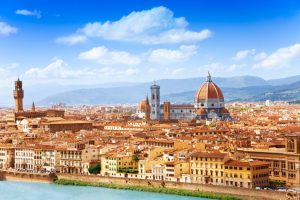
The cityscape of Florence
Amongst the early pioneers of the mercantile double-entry booking system, Florentine enterprise fuelled the rise and dominance of Italy in the culture sweepstakes. Sheer beauty captivates you on street after fascinating street, while architectural masterpieces stand in testimony to what was arguably the richest city in the medieval world. Noted for its innumerable collections of iconic works of art, Florence is also the resting place of greats like Galileo, Michelangelo, Dante and Machiavelli.
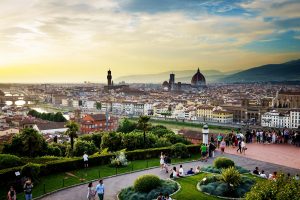
The Piazzale Michelangelo gives you a great view of Florence
Millions of tourists visit Florence every year to view and experience first-hand, the several iconic masterpieces that the city has won great acclaim for. Home to numerous art galleries and museums, Florence exerts considerable influence over the art and culture of Italy. The Historic Centre of Florence was declared a World Heritage Site by UNESCO in 1982, while Forbes magazine has ranked it as one of the most beautiful cities in the world. Florence has made great strides in the world of fashion too- it is ranked in the top 15 fashion capitals of the world.
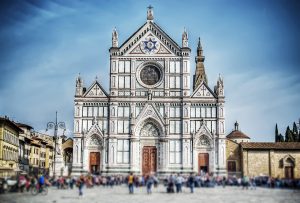
The Santa Croce Basilica where the tombs of Galileo, Michelangelo, Dante and Machiavelli are located
While Florence has much to offer to the visitor, experiencing all its attractions would involve an investment of considerable time and money. We have therefore selected the most important showpieces that best represent the zenith of its culture.
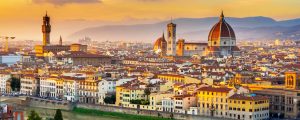
These are in the not-to-be-missed category; after all they are the iconic treasures that made Florence capture the imagination of the world in the centuries since the Renaissance.
Santa Maria del Fiore or Duomo
The Cathedral of Saint Mary of the Flower or Cattedrale di Santa Maria del Fiore in Italian is the main Cathedral in Florence.
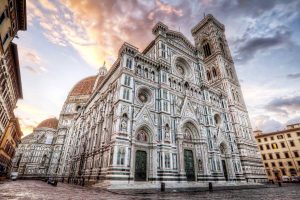
Designed by Arnolfo di Cambio work on the church began 9 September 1296, when the first stone was laid by Cardinal Valeriana, the first papal legate ever sent to Florence. It took nearly 140 years to complete this vast project due to a variety of reasons starting with the death of Di Cambio in 1302.
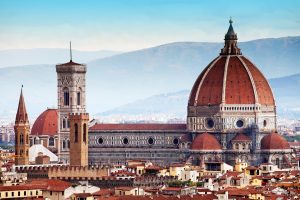
Cathedral of Saint Mary of the Flower or Florence Cathedral
The most striking feature of the Cathedral is its towering dome, measuring 114.5 metres in height. It was the tallest dome ever constructed, until the development of modern structural materials in the modern era. It still remains the tallest dome constructed of brickwork and masonry. Designed by Filippo Brunelleschi, the dome is considered one of the Renaissance’s major architectural showpieces.
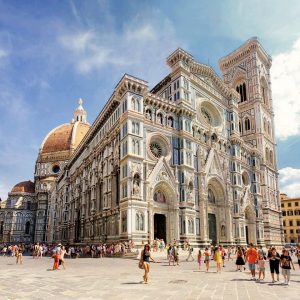
Outside the Florence Cathedral
Son of a wealthy Florentine Notary, Brunelleschi had been educated in a liberal manner. Although he was not a scholar, nor even particularly well-educated, Brunelleschi reasoned with practical experience. The architectural concept of linear perspective was first codified by Filippo Brunelleschi, who conducted a series of experiments between 1415 and 1420, which included making drawings of various Florentine buildings in correct perspective. The concept of the architect as designer and single person completely responsible for a project was first introduced by him.
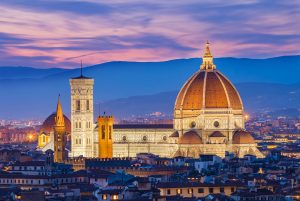
Cattedrale di Santa Maria del Fiore or Duomo
When in 1418, Brunelleschi won the Cathedral Vestry Board competition, to complete the church of Santa Maria del Fiore, his design was considered so revolutionary as to seem inconceivable. The adding of a vault to the original design of Di Cambio, caused diffidence among those tasked with the completion, besides much discontent among the workers.
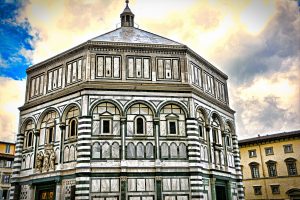
Baptistery of St John
That a huge statue of Brunelleschi now sits outside the Palazzo dei Canonici in the Piazza del Duomo, gazing at his greatest creation, is a stirring testament to the confidence the great man had in his design. He lies buried inside the Cathedral, in the part of the crypt close to the entrance. It is further proof of the high esteem in which Brunelleschi was held by the Florentines, to have been accorded so prominent a resting place.
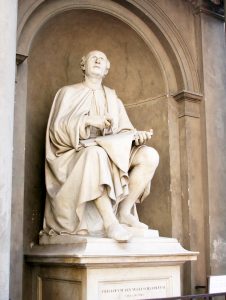
Filippo Brunelleschi
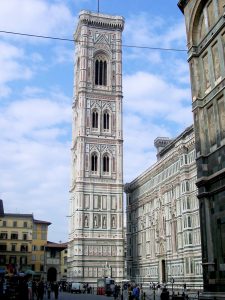
Giotto’s Bell Tower
Today the cathedral complex which includes the Baptistery of St John and Giotto’s Bell Tower or Campanile, is a part of the UNESCO World Heritage Site which covers the historic centre of Florence.
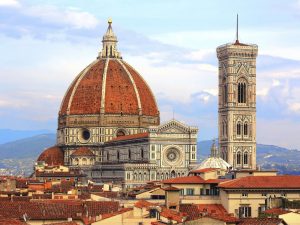
It is also the seat of the Archbishop of Florence, dating back to the times when it was directly subordinate to the Holy See at Rome. Being one of the largest churches in Italy, the Santa Maria del Fiore is one of major tourist attractions in Tuscany.
Uffizi Gallery
The celebrated Uffizi Gallery which is the pride of Florence boasts of a fascinating selection of masterpieces which no other gallery in the world could rival. It has been in continuous operation since 1591 and is considered to be one of the oldest museums in the world.
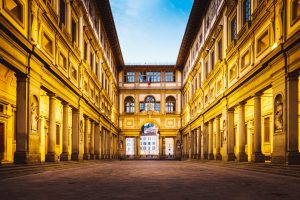
The Uffizi Gallery in Florence
The works of art that are part of this extraordinary collection have been added meticulously over the last four centuries. Florentine patronage to the arts has long been an essential element of its social milieu, where refinement was the hallmark of wealth.
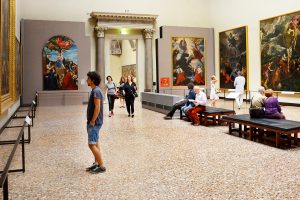
The Uffizi Gallery
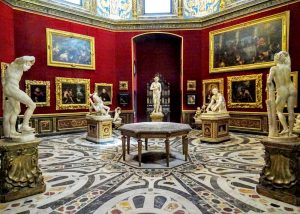
It is this patronage, of not just the powerful Medicis who ruled the city for much of the Renaissance, but also of several illustrious Florentine clans; that have made it possible for generations of art lovers to admire these priceless works of art. The Uffizi Gallery is a living proof of the generosity and enlightened minds of the Florentine aristocracy and its wealthy bankers, which catapulted it from its roots as a medieval museum to one of the world’s finest collections of art.
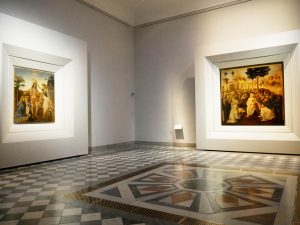
The Leonardo da Vinci Room at the Uffizi
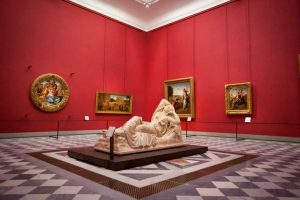
The Michelangelo Room at the Uffizi
Sprawled over 8,000 square meters and 45 rooms, the Uffizi Gallery hosts thousands of paintings, sculptures and miniatures, starting with the works of Cimabue from the 1200’s through the Middle Ages and into the modern era. The works of great painters like Giovanni Battista Tiepolo, Giovanni Antonio Canal (Canaletto) and Francesco Guardi figure prominently in the portfolio of the Uffizi Gallery.
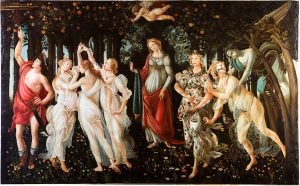
Spring by Sandro Botticelli, late 1470s or early 1480s
Also on display are an incredible collection of Florentine and Italian Renaissance pieces boasting of the works of masters like Leonardo da Vinci, Raphael, Michelangelo, Piero della Francesca and Paolo Uccello. Included in the repertoire is a large collection of the works of Botticelli, among which the ‘Birth of Venus’ and his famous ‘Spring’ are the most notable examples. Attracting in excess of two million visitors each year, the Uffizi Gallery figures high in the world’s most prominent tourist destinations.
Accademia Gallery
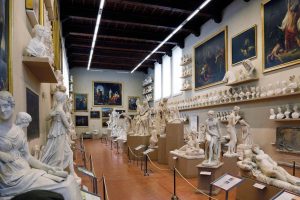
Sculptures at the Accademia Gallery
The Gallery of the Academy of Florence or the Galleria dell’Accademia di Firenze is an art museum that is most famous for the magnificent giant marble sculptures created by Michelangelo, and most of all, the iconic David.
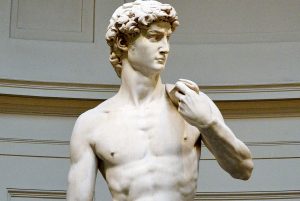
David by Michelangelo
Founded in 1784 by the Grand Duke of Tuscany Pietro Leopoldo, the Accademia Gallery is the second most visited art museum in Italy with over 1.6 million visitors in 2016. The most well known section in the Galleria is the Hall of the Prisoners, displaying the unfinished ‘Slaves’ by Michelangelo.
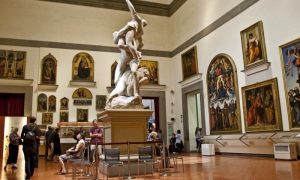
Giambologna’s Rape of the Sabine Women
The second most famous sculpture after the David is Giambologna’s Rape of the Sabine Women, which is also one of the proud exhibits of the Accademia. This was a sculpture that was prepared as an exercise in creating a group of three figures from just one large block of marble. What resulted is the masterpiece that has attracted millions from across the globe who wish to view it. Spread over two floors the treasures of the Accademia are not confined to only the sculptures of Michelangelo or Giambologna, as legendary as they may be.
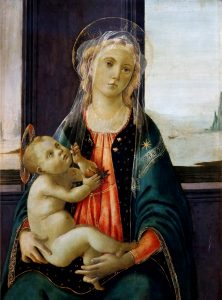
Madonna of the Sea by Sandro Botticelli, 1477
Adorning its walls are a large number of paintings of Florentine artists of the Early and High Renaissance such as Pietro Perugino, Filippino Lippi, Jacopo da Pontormo, Domenico Ghirlandaio and Agnolo di Cosimo aka Bronzino. Prominent among the artworks on display is the 1477 painting by Sandro Botticelli, ‘Madonna of the Sea’. While the painting gets its name from the seascape dimly visible in the background, its charm lies in the gold fine details and symbols that define the Madonna and the baby Jesus. Glittering on Mary’s dark blue robe is the star ‘Stella Maris’, while the pomegranate held by the baby Jesus is a symbol of Christ’s passion.
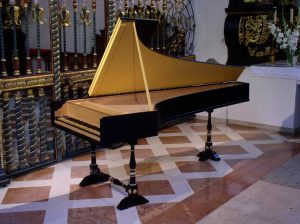
The original piano invented by Bartolomeo Cristofori
The Gallery also has a famous Music Room or the Museo degli strumenti musicali that opened in 2001. This is a must visit section, especially if you are a classical music fan. The piano which is so much an essential component in the classical music repertoire was invented by Bartolomeo Cristofori, a maker of musical instruments who was recruited to the court of Prince Ferdinando de Medici. The Medicis were well known patrons of art and music. The original piano invented by Cristofori is on display at the Music Room. You can also marvel at the extraordinary collection of harpsichords, violins, violoncellos and wind instruments.
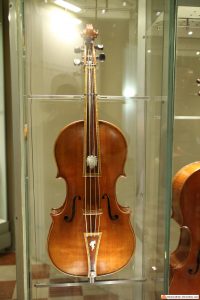
Stradivari Viola at the Accademia
The Music Room counts among its prize exhibits an array of rare musical instruments ranging from the violins made by the greatest of them all- Antonio Stradivari. They are reputed to produce sound of such quality that has defied attempts to explain or equal it for centuries. Their fame has passed into popular folklore and the name Stradivari appears in numerous works of fiction. Also in the arsenal of the Gallery is the Grand Ducal collection of forty instruments belonging to the Luigi Cherubini Conservatory. The other great violin maker, Niccolo Amati is also represented in the Accademia’s collection.
House of Dante
But then Florence is not just about paintings. It is the birthplace of Dante Alighieri, the father of Italian literature, whose work ‘Divine Comedy’ is counted as one of the greatest pieces of the world’s literature.

Dante Alighieri
So influential were his writings that he said to have inspired the works of masters like John Milton, Geoffrey Chaucer and Alfred Tennyson. The politics of those times led to the great poet being expelled from Florence for life, to which city he tried many times to return, although unsuccessfully. His soul was set at rest when finally in 2008, the Municipality of Florence officially apologised for expelling Dante 700 years earlier.
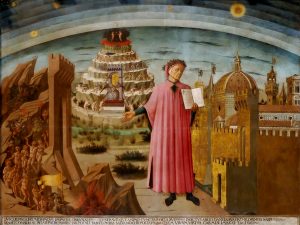
Divine Comedy by Dante
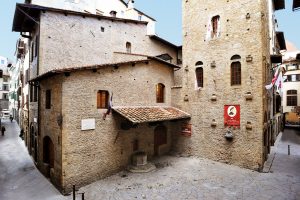
The House of Dante
Florence also set up a museum named The House of Dante where his works are displayed. The museum’s collection is spread over three floors and displays not just the literature he produced, but also a sizeable collection of paintings, images and artifacts from his lifetime.
Bargello National Museum
Yet another of Florence’s museums, the Bargello is a former courthouse-cum-prison, now turned art museum. It is also known as Palazzo del Bargello, Museo Nazionale del Bargello, or Palazzo del Popolo (Palace of the People) in Italian and houses some of the most beautiful sculptures from leading artists of the Renaissance period. Displaying the legendary works of greats like Michelangelo and Donatello, the Bargello is to sculpture what the Uffizi is to painting.
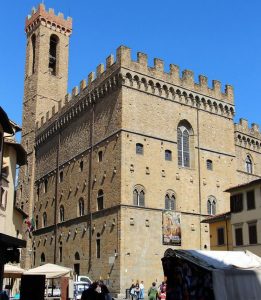
The Bargello prison turned museum
The Palazzo del Podesta as this three storey building was originally called, is the oldest surviving public building in Florence. Construction of the building began in 1255 and it served as the office of the Podesta or the highest magistrate of the Florence City Council. In 1574, the Medici rulers abolished the office of the Podesta, after which the building housed the Bargello or the police chief of Florence. Executions took place in the open courtyard, until they were abolished in 1786 by Grand Duke Peter Leopold, one of the earliest opponents of capital punishment.

Inside the Bargello National Museum
In 1859, the year the Holy Roman Emperor Peter Leopold was exiled, it was decided by the makeshift Governor of Tuscany that the Bargello should serve greater purposes. And thus in 1865, it was converted into a national museum and began life anew as a haven for art lovers. Its collection of Gothic and Renaissance sculptures is reputed to be amongst the largest in Italy.

Grand Duke Peter Leopold
Masterpieces by Michelangelo include Bacchus, Pitti Tondo (or Madonna and Child), Brutus and David-Apollo. Donato di Niccolo di Betto Bardi (1386-1466), better known as Donatello is another well known sculptor whose works such as David and St George’s Tabernacle, are on display at the Bargello. Other sculptures by Donatello that are displayed include a bronze David, the Atys and the Marzocco. Works of Donatello’s pupils, Desiderio da Settignano (1430-1464), and Antonio Rossellino (1427-1479) are also placed in the same hall.

St George by Donatello
Glazed terracotta figures from the Renaissance period are also on display. Most noteworthy of these is the Madonna with Child created by Luca Della Robbia (1400- 1482). There are other figures of glazed terracotta created by Andrea and Giovanni Della Robbia which are placed in two rooms on the second floor.
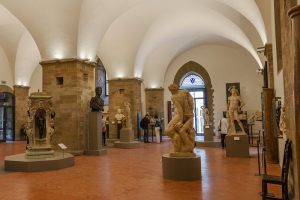
Sculptures at the Bargello
Another room named after Andrea del Verrocchio (1435-1488) displays his work the bronze David and the Lady with the Posy. Among Verrocchio’s most famous apprentices were the all time great Leonardo da Vinci and also Lorenzo di Credi. The Verrocchio room also has a remarkable collection of busts of Florentine personalities made by some of the most important 15th century artists. A portrait of Costanza Buonarelli by Gian Lorenzo Bernini is most noteworthy.

Madonna with Child by Luca della Robbia
A lavish collection of medals belonging to the Medici family are among the other prize exhibits. Works by Sansovino (1460-1529), Jacopo Sansovino (1486-1570), Baccio Bandinelli (1488- 1560) and Bartolomeo Ammannati (1511-1592) add to the Bargello’s wide repertoire.
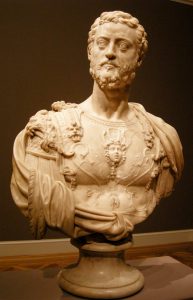
Bust of Cosimo I by Benvenuto Cellini
The model of Perseus, the bronze bust of Cosimo I, by Benvenuto Cellini and the much admired Mercury by Giambologna (1529-1608) add to this already formidable collection.
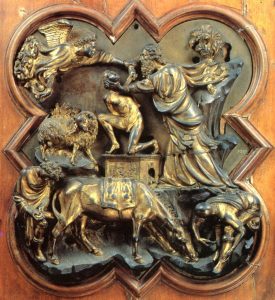
Sacrificio di Isacco by Brunelleschi
Two panels depicting the Sacrifice of Isaac (Sacrificio di Isacco) made by Lorenzo Ghiberti and Filippo Brunelleschi, to win the contest for the second set of doors of the Florence Baptistery (1401), are also on display at the Bargello National Museum. The Bargello also boasts of a fine collection of ceramics, ivory, armour and coins. In 1982, the Islamic Hall at the Bargello was set up by Marco Spallanzani and Giovanni Curatola.
Palazzo Pitti (Pitti Palace)
Famed for its exceptional size and unprecedented scale of architecture, the Palazzo Pitti is the largest palace in Florence. Its sheer size and scale has been the inspiration for several royal residences across Europe from Madrid to Vienna, from St Petersburg to Paris. Originally designed by Filippo Brunelleschi, whose other great work was the dome of the Florence Cathedral, the Palazzo Pitti or the Pitti Palace was commissioned by Luca Pitti, an ambitious Florentine banker in 1458.
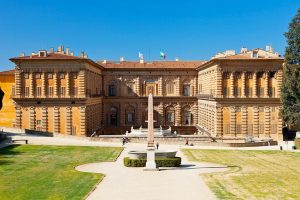
The Palazzo Pitti
Legend has it that Luca Pitti approached Brunelleschi and chose the project turned down by his traditional rival Cosimo the Elder de’ Medici, for being too large and expensive. It is said that Pitti insisted that the windows of his new palace be wider than the front door of the Medici palace. A visit to the Pitti Palace is indeed an enriching experience, as it is home to some of the most beautiful paintings in the world; including some by renowned names like Raphael and Titian. Its magnificent park, the Boboli Gardens is an inspiration and forerunner to many Italian-style gardens.
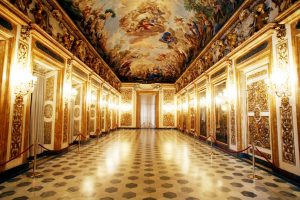
The Medici palace
The palace is situated on the south side of the River Arno, a short distance from the Ponte Vecchio. In a twist of fate and overburdened by debt, the Pitti family were forced to sell the palace to their long standing rivals, the Medici. This vast Renaissance style palace was purchased in 1549 by Eleonora di Toledo the wife of Cosimo I de’ Medici who later became the Grand Duke of Tuscany. The Medici were however gracious enough to retain the name of its founder, and that is the name the Palazzo goes by to this date.
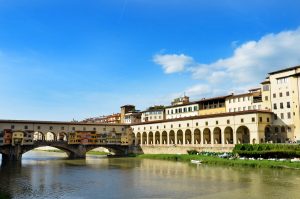
The Vasari Corridor
Cosimo had the architect Giorgio Vasari modify the Palazzo to suit his taste, who more than doubled its area by adding a new block towards the rear. He also built the Vasari Corridor, which was an above ground walkway from the Palazzo Vecchio, Cosimo’s old palace and the seat of government, through the Uffizi, above the Ponte Vecchio to the Palazzo Pitti. The purpose was to provide safe and convenient passage for the Grand Duke and his family between the various buildings.
It was in the reign of Eleonora’s son Francesco I and his wife Johanna of Austria that the Medici family permanently moved into the Palazzo Pitti, becoming home to the Medici’s art collection. The collection grew in size as later generations of the Medici family amassed paintings, plates, jewellery and luxurious artifacts. The French Emperor Napoleon occupied the palace in the late 18th century and used it as a power base. With the formation of the Kingdom of Italy, which united its various constituent regions, the Palazzo served as the main palace for a brief period. King Victor Emmanuel III, the king of Italy donated the palace and its contents to the Italian people in 1919.
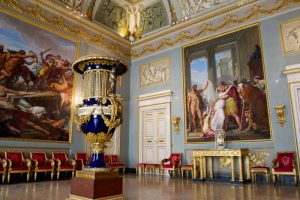
The Palatine Gallery one of the museums at the Palazzo Pitti
The Palazzo Pitti is the largest museum complex in Florence. Spread across several museum blocks, the Palazzo is built to mammoth proportions. Its total area is huge, the principal palazzo block or the corps de logis alone measuring 32000 square metres. About 140 of its rooms are open to the public and house some of the most valuable paintings, sculptures and works of art to have ever been collected.

The Palatine Gallery at the Palazzo Pitti
The main gallery of the Palazzo Pitti is called the Palatine Gallery, which is designed on the lines of a private art collection. It is adorned with over 500 paintings, largely from the Renaissance, which once formed part of the Medici art collection. Not surprisingly, the gallery merges with what were once the royal apartments of the Medici’s. On display are works by Raphael, Tiziano Vecellio or Titian, Pietro Perugino (Lamentation over the Dead Christ), Antonio da Correggio, Peter Paul Rubens, and Pietro da Cortona.

Lamentation over the Dead Christ by Pietro Perugino, 1495
While the Palatine Gallery comprises 28 rooms, the Royal Apartments extend to 14 rooms. Other important museums in the Pitti Palace are the Gallery of Modern Art, the Grand Dukes Treasury, the Porcelain Museum, the Costume Gallery and the Carriages Museum. Each is a separate museum in its own right and each of them boasts of mind boggling collections in their respective spheres.
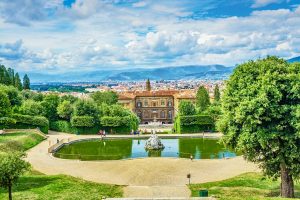
The Palazzo Pitti set amidst the Boboli Gardens
Today the Palazzo is administered by the Italian government, transformed from a royal palace to State Museum. Since 2015 the Palazzo has been made a part of the Uffizi Gallery, but as an independent and separate unit within the Ministry of Cultural Properties and Activities. Grandly overlooking the city of Florence from its elevated location, the Palazzo still retains the ambience of a royal property despite the state owned nature of its present administration. This is largely due to its ecosystem of volunteers and patrons who founded the Amici di Palazzo Pitti or Friends of the Palazzo Pitti in 1996, to raise funds and suggest improvements for what is arguably one of the world’s finest and largest collections of art.
3 Comments
[…] origins of the Easter lily are obscure. However, art from the 14th-century pre-Renaissance period depicts the archangel Gabriel at the Annunciation with a lily. The lily symbolised purity and birth […]
[…] Art might not have progressed on the lines it subsequently did. There probably would have been no Renaissance, and figures like Michelangelo might not have […]
Leave a Comment
You must be logged in to post a comment.



[…] over art and religion across Europe and indeed across the globe. When combined with Rome and Florence, this charming Umbrian town in Central Italy is an excellent place to gain a deeper and more […]